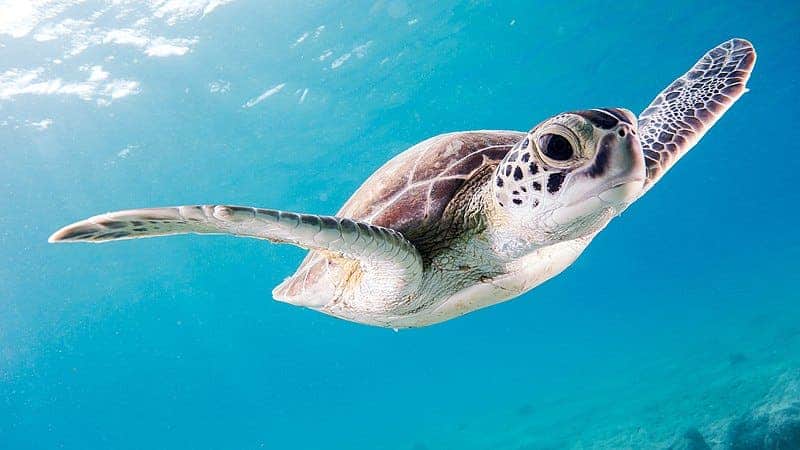
Plastic pollution is so rampant in the oceans that it has created an “evolutionary trap” for juvenile sea turtles. This was the conclusion of a new study that found plastic in most juvenile turtles they caught along both the Pacific and Indian Ocean coasts of Australia.
The plastic trap
An evolutionary trap occurs when a previously adaptive behavior now has negative effects on the overall survival and reproduction of an organism. This usually happens when a species’ habitat is altered much faster than the organism can adapt. These traps are quite perverse since species are deceived into making poor habitat choices based upon formerly reliable environmental cues — even when higher quality habitat or resources are still available.
For instance, changing land use in an isolated Nevada meadow has driven the extinction — and subsequent recolonization — of a local population of checkerspot butterflies (Euphydryas editha).
In this particular case, newly hatched turtles have adapted to enter the oceanic zone where they travel on currents, feeding and growing to maturity. These habitats are ideal for their development, mainly because that’s where ample food is being funneled straight to their mouths. The problem is that the same currents also carry plastic debris.
“Juvenile turtles have evolved to develop in the open ocean, where predators are relatively scarce,” said Dr. Emily Duncan, of the Centre for Ecology and Conservation on Exeter’s Penryn Campus in Cornwall. “However, our results suggest that this evolved behavior now leads them into a ‘trap’ – bringing them into highly polluted areas such as the Great Pacific Garbage Patch.
“Juvenile sea turtles generally have no specialized diet – they eat anything, and our study suggests this includes plastic,” she added.
Researchers at the University of Exeter in the UK and Murdoch University in Australia looked at how much and what type of plastics are ingested by small juvenile turtles. The study included 121 sea turtles from five of the world’s seven species: green, loggerhead, hawksbill, olive ridley, and flatback.
The results showed that the vast majority of turtles from the Pacific coast had plastic inside them: 86% of loggerheads, 83% of greens, 80% of flatbacks, and 29% of olive ridleys. On the Indian Ocean coast, the proportion of turtles containing plastic was much smaller, but still concerning. There, 28% of flatbacks, 21% of loggerheads, and 9% of green turtles contained plastic.
No plastic was found in hawksbill turtles on either coast, but this is likely due to the very small sample size consisting of only seven hawksbill.
All the animals included in the study were stranded post-hatchlings and bycaught oceanic juveniles from the longline fisheries in the Coral Sea.
Plastics now represent 80% of all marine debris and can be found virtually everywhere, from surface waters to deep-sea sediments. This debris is generally classed as either macroplastics (with a diameter greater than 1mm) and microplastics (smaller than 1mm). But for the purpose of this study, the researchers classed the debris according to color and type (hard plastics, rope, or plastic bags).
The highest number of ingested plastic pieces occurred in green turtles: one animal in the Indian Ocean contained 343 pieces, and one animal in the Pacific Ocean contained 144.
“Plastic in the Pacific turtles was mostly hard fragments, which could come from a vast range of products used by humans, while Indian Ocean plastics were mostly fibers – possibly from fishing ropes or nets,” says Duncan, who is the lead author of the study.
The most commonly ingested polymers in both oceans were polyethylene and polypropylene. However, these plastics are so widely used in products that it’s impossible to trace the source. As such, there is no viable solution other than stopping plastic pollution as much as possible at its land-based source before it reaches the ocean.
It’s still not clear how the turtle juveniles’ health is affected by ingesting plastic, though scientists suspect it can lead to malnutrition, chemical contamination, and even death from laceration, obstruction, and perforation of the gastrointestinal tract.
“Hatchlings generally contained fragments up to about 5mm to 10mm in length, and particle sizes went up along with the size of the turtles,” Duncan said.
“The next stage of our research is to find out if and how plastic ingestion affects the health and survival of these turtles. This will require close collaboration with researchers and veterinarians around the world,” she added.
The findings were reported in the journal Frontiers in Marine Science.






